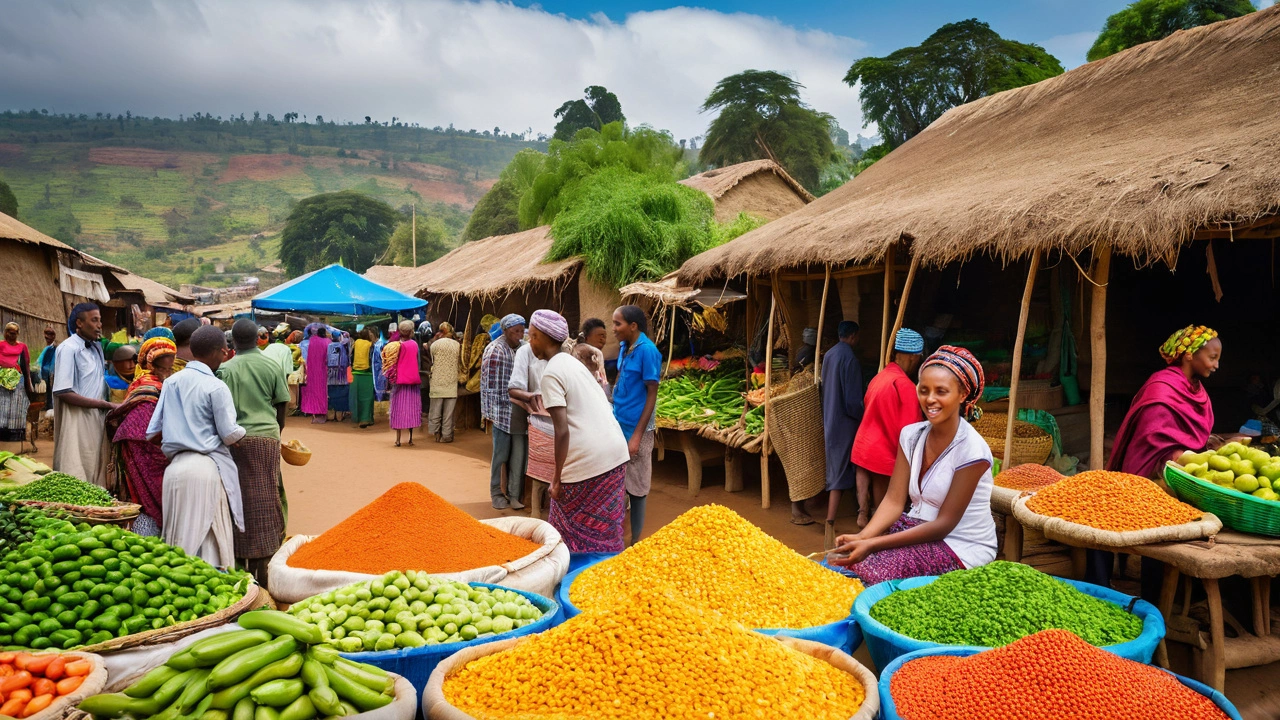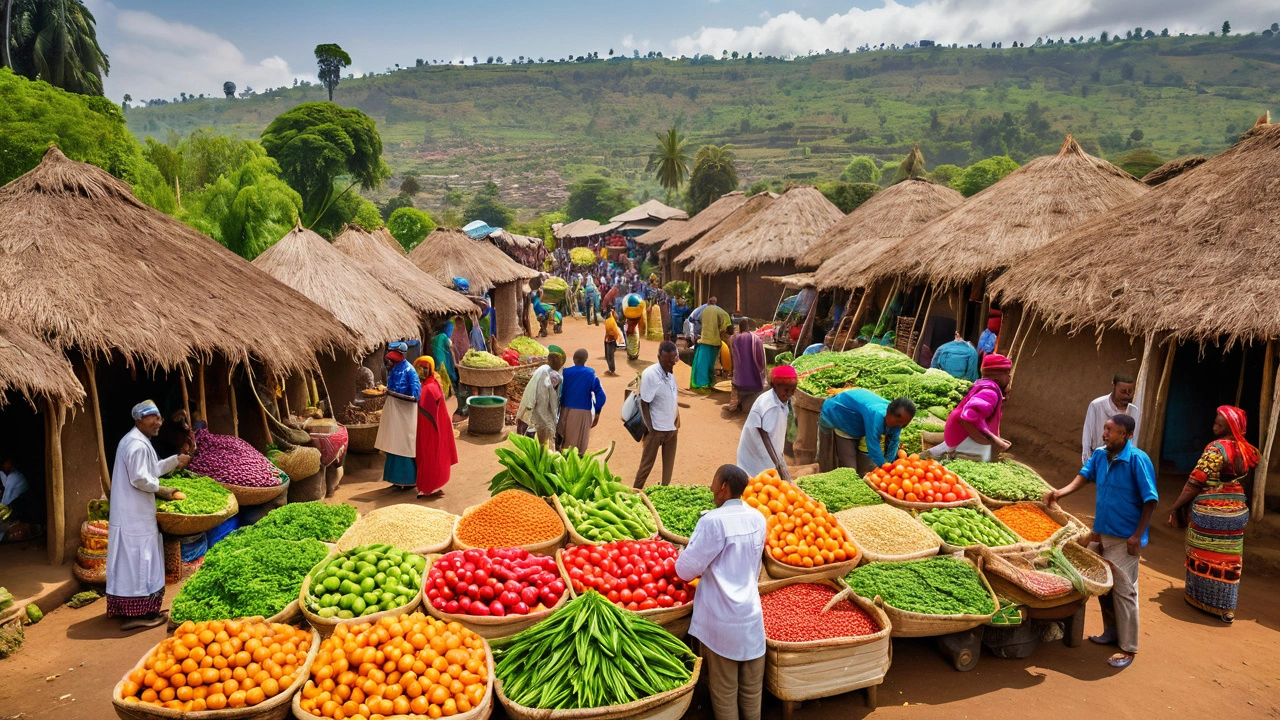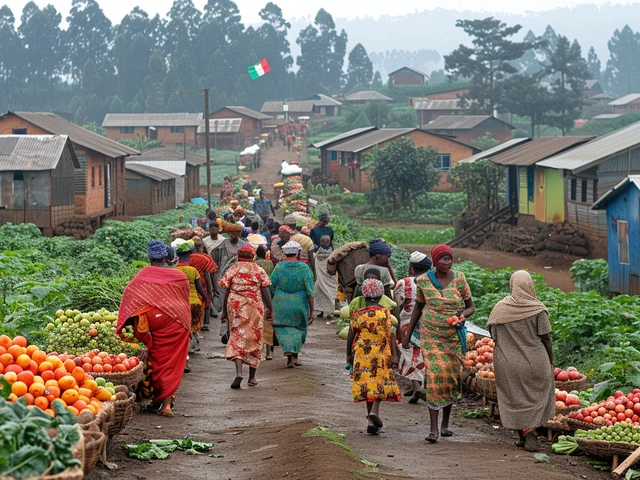Ethiopia is a country teeming with rich culture and remarkable landscapes, but it's the people’s diverse skills and adaptability that truly stand out. Understanding the various ways Ethiopians make money offers a glimpse into a nation that harmonizes tradition with innovation.
Agriculture remains a cornerstone of Ethiopia’s economy. With millions relying on farming, crops like coffee and teff play a significant role. Yet, beyond farming, Ethiopians showcase their rich heritage through handicrafts and artisanship, creating products that captivate both local and international markets.
The tourism sector is also a driving force, with Ethiopia's historical sites and natural wonders drawing visitors from around the world. In recent years, the technology landscape has started evolving, bringing opportunities for start-ups and tech enthusiasts.
Trade and commerce are integral, too. From bustling local markets to larger trade ventures, commerce is a vital part of daily life. Each of these avenues highlights the ingenuity and resilience of Ethiopia’s people in finding ways to make a living.
- Agricultural Practices
- Handicrafts and Artisanal Work
- Tourism and Hospitality
- Technology and Start-ups
- Trade and Commerce
Agricultural Practices
In Ethiopia, agriculture is the backbone of the economy, offering livelihoods to millions and making up a significant portion of the country’s GDP. The diverse landscapes and climates allow for a variety of crops, making farming a versatile and inclusive occupation for many. One of the country's most famous agricultural exports is coffee. Often referred to as the birthplace of coffee, Ethiopia is renowned for its Arabica coffee beans, which are cherished globally for their unique flavor profiles. Smallholder farmers, who cultivate coffee on small plots of land, dominate the coffee production sector.
Besides coffee, another vital crop is teff, a grain unique to Ethiopia and Eritrea. Teff is not only a staple in Ethiopian cuisine but also an important economic crop. It's used to make injera, a national dish enjoyed across the country. Farming practices in Ethiopia often use traditional methods, though there is a growing movement towards modern agricultural technologies. These are gradually being adopted to increase productivity and sustainability.
The government and various non-governmental organizations have been working to support farmers by providing access to better seeds, training on modern techniques, and introducing irrigation solutions. Despite these efforts, Ethiopian farmers face several challenges. The reliance on rain-fed agriculture makes them vulnerable to changing weather patterns and climate change. Drought remains one of the biggest threats, affecting crop yields and heightening food insecurity in rural areas.
To mitigate these issues, there has been a push towards developing more resilient farming methods. Agroforestry, for example, integrates trees and shrubs into crops and livestock systems, which helps in sustaining the environment. Farmer cooperatives also play an important role, allowing farmers to pool resources, share knowledge, and access broader markets. This collective approach has empowered farmers to negotiate better prices and reduce input costs.
Agricultural practices in Ethiopia are not limited to crops alone. Livestock farming is another essential part of the rural economy. Cattle, sheep, and goats are commonly raised, providing a source of income through the sale of meat, milk, and hides. Traditional livestock management practices are often used, though there is a rising trend towards more intensive and profitable methods.
Women play a significant role in Ethiopian agriculture, often involved in planting, weeding, harvesting, and post-harvest processing. Promoting gender equality in agriculture is becoming an increasing focus, with initiatives aimed at empowering women farmers by giving them better access to land, resources, and training.
Despite the challenges, Ethiopia's agricultural sector remains vibrant, driven by the hard work and ingenuity of its people. Supporting this sector through innovation and sustainable practices poses a vital opportunity for enhancing food security and building a stronger economy.
According to ActionAid, "Empowering women farmers can increase farm yields by 20-30%, significantly boosting national food security."
Handicrafts and Artisanal Work
Handicrafts and artisanal work represent an important aspect of Ethiopia’s cultural and economic fabric. The country's rich history and diverse ethnic makeup have given rise to a wide array of traditional crafts. These include intricate textiles, pottery, jewelry, leatherwork, and wood carving, each reflecting the unique cultural heritage of the artisans. One such example is the woven baskets, known locally as “mesobs.” These colorful and intricately designed items are often made from natural fibers like grass and reeds.
The production of textiles, particularly traditional cloths called “shema,” is another significant aspect of Ethiopian handicrafts. These hand-woven fabrics are commonly used to make traditional clothing such as the “habesha kemis” for women and “gabi” or “netela” for men. The weaving is mostly done on pit looms in rural homes, and the techniques have been passed down through generations. According to a study by the Ethiopian Ministry of Culture and Tourism, the handicraft sector contributes to about 5% of the country's GDP and employs a significant portion of the population.
Artisanal craftwork in Ethiopia is not only tied to cultural heritage but also provides a vital source of income for many families. Artisans often form cooperatives to enable better access to markets and resources. These cooperatives may also offer training and support to enhance the quality of the products. One local artisan, Abebe Makonnen, a renowned potter from the southern region, stated, “Handicrafts are more than just a means of making a living; they are a way to preserve our history and pass it on to the next generation.”
Handicrafts are more than just a means of making a living; they are a way to preserve our history and pass it on to the next generation. - Abebe Makonnen
In recent years, the international demand for Ethiopian artisanal products has grown. Tourists and foreign markets have developed an appreciation for the craftsmanship and cultural significance of these items. Organizations like the “World Fair Trade Organization” have highlighted the importance of fair trade practices in ensuring that artisans receive fair compensation for their work. This exposure has led to better marketing strategies and higher incomes for the artisans.
However, artisans face several challenges. Limited access to raw materials and modern tools can hinder the production process. Moreover, undeveloped infrastructure in rural areas can make it difficult for artisans to reach broader markets. Nevertheless, initiatives by non-governmental organizations and governmental bodies aim to address these issues. For instance, programs that provide micro-financing and access to more efficient production methods are helping artisans enhance their craft and market reach.
The resilience and creativity of Ethiopian artisans are evident in their stunning works of art. By merging traditional techniques with contemporary designs, they have managed to continuously captivate both local and international audiences. This unique blend of the past and present ensures that Ethiopian handicrafts remain a vibrant and integral part of the country’s economic and cultural landscape.

Tourism and Hospitality
Ethiopia has established itself as a must-see destination for travelers, thanks to its combination of ancient history, diverse cultures, and stunning natural beauty. This sector significantly contributes to the livelihood of many Ethiopians by creating a variety of job opportunities. People work as tour guides, hospitality staff, and even entrepreneurial roles such as owning and running guesthouses or transport services for tourists.
One of the crown jewels of Ethiopian tourism is the rock-hewn churches of Lalibela, a UNESCO World Heritage site. These incredible structures draw visitors from all over the world, who are fascinated by the historical significance and architectural marvel. Locals benefit by offering guided tours, selling handmade crafts, and providing accommodation.
"Tourism has the potential to become Ethiopia's leading source of foreign currency," said Sileshi Girma, CEO of Ethiopian Tourism Organization.
The Simien Mountains offer another popular attraction. Trekkers and adventure seekers come here to experience breathtaking landscapes and unique wildlife. Local communities have adapted by offering trekking services, renting out equipment, and providing lodging. The presence of visitors has prompted an increase in small businesses like restaurants and cafes, where tourists can sample traditional Ethiopian cuisine such as injera and doro wat.
The renowned coffee culture is another significant draw for tourists. Ethiopia is the birthplace of coffee, and the coffee ceremonies are a cultural treasure. Coffee tours where visitors can learn about the entire coffee-making process, from bean to cup, have become increasingly popular. These tours not only educate tourists but also generate income for small-scale farmers and local guides.
Economists point out that the MICE (Meetings, Incentives, Conferences, and Exhibitions) sector is another growing facet of Ethiopian tourism. Cities like Addis Ababa, with its modern convention centers and hotels, are becoming hubs for international conferences and business events. This growth creates numerous job opportunities, from event planning and catering to tech support and transportation services.
Tourism in Ethiopia doesn't merely end with the rich historical and natural sites. Urban tourism in cities like Addis Ababa introduces visitors to a vibrant mix of modernity and tradition. The bustling streets adorned with local markets, modern cafes, art galleries, and music festivals provide a fantastic urban experience for travellers. City tours often focus on landmarks like the National Museum, where visitors can see the fossilized remains of 'Lucy,' one of the oldest known hominids.
The hospitality industry is vital to ensuring a positive tourist experience. Ethiopians are renowned for their exceptional hospitality, something deeply rooted in their culture. This reputation is encouraged through professional training programs and institutions focusing on tourism and hospitality management. Enhancing the skills of those working in this sector translates into better services, making Ethiopia a more attractive destination.
Technology and Start-ups
In recent years, Ethiopia has witnessed a surprising yet thrilling rise in its technology sector. Though traditionally known for its agricultural backbone, the country is steadily evolving into a hub for innovation and start-ups. This transformation is propelled by a youthful population that's eager to embrace the digital age.
At the heart of this technological surge is the capital city, Addis Ababa. Home to several burgeoning tech hubs and co-working spaces, the city is where innovation happens. Start-ups here focus on a range of solutions, from addressing healthcare challenges to boosting agricultural efficiency. This diversity in focus showcases the broad impact technology can offer. A notable example is the mobile money platform, HelloCash, which has revolutionized financial inclusion for millions.
The fervor for technology isn't limited to urban areas. Rural parts of Ethiopia are also experiencing a tech revolution, albeit at a different pace. Initiatives like Digital Ethiopia 2025 aim to bridge the digital divide, ensuring that even remote communities can leverage technology for development. These measures are creating a fertile ground for start-ups that want to make a difference in agriculture, education, and health.
What's particularly impressive is the government's proactive stance in fostering this innovation-driven environment. Programs like the Ethiopia ICT Park serve as incubators for start-ups, providing them with the necessary tools and resources to thrive. These initiatives are crucial because they offer the infrastructure and support that many young entrepreneurs need to actualize their ideas.
The Prime Minister himself has stated, "We want to make Ethiopia the leading tech hub in Africa by 2025." This ambition underscores Ethiopia's commitment to harnessing technology as a cornerstone of its economic progress.
Another driving factor behind Ethiopia's tech boom is the increased access to the internet and mobile technology. With telecom liberalization on the horizon, internet penetration is expected to soar, bringing with it countless opportunities. The availability of faster, more reliable internet will enable start-ups to scale, reaching customers both locally and internationally.
Education also plays a critical role in nurturing the next generation of entrepreneurs. Institutions like Addis Ababa University are offering courses in ICT and entrepreneurship, equipping students with the skills they need to succeed in the digital economy. Partnerships with international tech giants provide additional exposure and learning opportunities, further preparing these young minds for the challenges ahead.
Despite these strides, challenges remain. Issues like electricity shortages and limited access to funding can hinder progress. However, the resilience and ingenuity of Ethiopian entrepreneurs cannot be overstated. They find creative solutions, often leveraging community support and alternative financing methods like crowd-funding to keep their dreams alive.
Ethiopia's burgeoning tech landscape is a testament to the nation's capacity for growth and transformation. By focusing on technology and start-ups, Ethiopia is not just keeping up with the global pace but is carving out a niche for itself as an African leader in innovation. The journey is ongoing, but with the right support systems in place, the future looks promising.

Trade and Commerce
In Ethiopia, trade and commerce form an indispensable part of everyday life. From bustling city markets to rural trading posts, the exchange of goods and services is a lifeline for many Ethiopian communities. The country’s strategic location in the Horn of Africa gives it a unique advantage in regional trade, linking it to neighboring countries like Djibouti, Kenya, and Sudan.
Mercato, situated in Addis Ababa, is one of the largest open-air markets in Africa. It is a maze of stalls and shops selling everything from spices and textiles to electronics and household items. Here, traders and customers haggle over prices, creating an energetic atmosphere that captures the spirit of Ethiopian commerce. The market is not just a place for transactions; it's a social hub where people meet, share news, and build connections.
Interestingly, much of Ethiopia’s trade relies on agricultural products. Coffee, for instance, is a significant export item. Ethiopia is the birthplace of coffee, and the beverage is more than just an economic asset; it is a cultural cornerstone. Exports of coffee earn the country significant foreign exchange, which is crucial for its development projects. Similarly, livestock trade, including cattle and goats, is a vital economic activity, especially in rural areas.
Another noteworthy aspect of Ethiopian commerce is the expanding sector of artisanal crafts. Ethiopian artisans produce beautiful handwoven fabrics, pottery, and jewelry that attract both local and international buyers. These crafts are often sold in city markets, tourist spots, and increasingly online, providing income for families and promoting Ethiopia's rich cultural heritage.
In recent years, technology has also started transforming trade in Ethiopia. E-commerce platforms are emerging, allowing vendors to reach broader markets without geographical limitations. This shift is proving beneficial, especially for small businesses and entrepreneurs who previously had limited access to distant customers.
An essential part of trade in Ethiopia is the emphasis on ethical and sustainable practices. Many cooperatives and businesses are adopting fair trade principles, ensuring that producers receive fair compensation for their goods. This approach not only enhances the livelihoods of the workers but also improves the quality and marketability of Ethiopian products.
Additionally, efforts are being made to enhance logistics and transportation networks. Infrastructure developments such as improved roadways and railway connections are facilitating smoother and quicker movement of goods within the country and across its borders. These improvements are critical for boosting trade efficiency and reducing costs, thus making Ethiopian products more competitive globally.
However, trade and commerce in Ethiopia are not without challenges. Issues like fluctuating market prices, restrictive government policies, and occasional political instability can disrupt business activities. But Ethiopians are known for their resilience, and they continue to find ways to thrive despite these obstacles.
In essence, trade and commerce in Ethiopia are vibrant and multifaceted sectors that drive the economy and support the livelihoods of its people. By leveraging its unique resources and embracing innovation, Ethiopia continues to strengthen its trade networks, both locally and internationally.

 Exploring Ethiopia's Economic Backbone: Top Exports Driving Growth
Exploring Ethiopia's Economic Backbone: Top Exports Driving Growth
 Exploring the Warmth of Ethiopia: Are Ethiopians Truly Friendly?
Exploring the Warmth of Ethiopia: Are Ethiopians Truly Friendly?
 Leading Causes of Death in Ethiopia: A Detailed Overview
Leading Causes of Death in Ethiopia: A Detailed Overview
 Discover the Highest Paid Jobs in Ethiopia: An In-Depth Guide
Discover the Highest Paid Jobs in Ethiopia: An In-Depth Guide
 Average Monthly Salary in Ethiopia: Understanding the Financial Landscape
Average Monthly Salary in Ethiopia: Understanding the Financial Landscape
Frankie Mobley
July 21, 2024 AT 17:43Ethiopia's farms are the heart of the country, and most families depend on coffee and teff to earn a living. Smallholder farmers grow coffee on tiny plots, and the beans are famous worldwide for their flavor. The government is trying to give them better seeds and training so crops can survive dry spells. Women also work hard in the fields, doing planting, weeding and processing. All of this shows how resilient Ethiopian farmers are.
ashli john
July 21, 2024 AT 18:40Sounds great keep it up
Kim Chase
July 21, 2024 AT 20:03Yo, thanks for the shoutout! I think it’s super important we all uplift the farmers, no matter where they’re from. The stuff they do is real lifeline for the whole nation. Plus, tech can help them beat droughts if we give them the right tools.
David Werner
July 21, 2024 AT 21:26Ever notice how the new tech hubs in Addis feel like secret laboratories? They're not just about apps and start‑ups; they're breeding grounds for a digital surveillance state. Every mobile payment you make feeds a data mine that the powers-that‑be can weaponize. And the government’s open‑door policy on foreign investors? That's a backdoor for hidden agendas. We should ask who really benefits when Ethiopia touts itself as the next Silicon Valley.
Paul KEIL
July 21, 2024 AT 22:16Strategic tech diffusion without robust governance frameworks invites systemic risk; leveraging capital influx without aligning regulatory compliance undermines sovereign data autonomy
Horace Wormely
July 22, 2024 AT 00:13Handicrafts remain a vital economic pillar in Ethiopia, linking cultural heritage with modern market demand. Artisans produce intricate textiles, pottery, and jewelry that attract both local buyers and tourists. Cooperative models have improved access to finance and training, allowing craftsmen to increase product quality. Moreover, fair‑trade initiatives help ensure that artisans receive equitable compensation for their work. Continued investment in infrastructure and digital platforms can further expand their reach internationally.
christine mae cotejo
July 22, 2024 AT 05:46Tourism in Ethiopia is more than a simple industry; it is a living tapestry woven from ancient history, vibrant culture, and breathtaking landscapes. When travelers step onto the stones of Lalibela, they are not merely witnessing architecture, they are touching centuries of faith and perseverance. The rock‑hewn churches whisper stories of monks who carved sanctuaries by hand, a testament to human devotion that still draws pilgrims from across the globe. In the Simien Mountains, the sheer cliffs and endemic wildlife create a stage for adventure seekers who crave both challenge and wonder. Each trek through misty highlands reveals hidden villages where hospitality is offered with a warm smile and a steaming cup of coffee, embodying the renowned Ethiopian generosity. The coffee ceremonies themselves are a micro‑performance, a ritual that showcases the nation’s claim as the birthplace of coffee, and they serve as a cultural bridge between visitor and host. Urban tourism in Addis Ababa brings another layer of experience, where modern cafés sit beside bustling markets filled with spices, fabrics, and the rhythmic chatter of traders. Museums and galleries celebrate Ethiopia’s artistic legacy, from ancient fossils like Lucy to contemporary street art that voices the youth’s aspirations. The hospitality sector has responded by professionalizing training programs, ensuring that service standards meet international expectations while preserving authentic warmth. Small‑scale guesthouses often double as community hubs, channeling tourist spending directly into neighborhood economies. Seasonal festivals light up the streets with music, dance, and colorful attire, inviting outsiders to participate in celebrations that have been passed down through generations. These events also generate seasonal employment for countless individuals who otherwise rely on agriculture. Moreover, the expansion of conference facilities in the capital positions Ethiopia as a hub for MICE tourism, attracting business travelers who bring high‑value spending. This diversification reduces reliance on a single tourism niche and spreads economic benefits across sectors. The government’s investment in infrastructure, from road improvements to airport expansions, further integrates remote attractions into the national tourism circuit. Ultimately, tourism in Ethiopia is a dynamic engine that fuels job creation, cultural preservation, and international visibility, weaving together the old and the new into a resilient economic fabric.
Douglas Gnesda
July 22, 2024 AT 07:10Spot on! The cooperative model is basically a decentralized supply chain that leverages collective bargaining power, boosting both margin and market penetration. By integrating digital marketplaces, artisans can scale beyond local bazaars, tapping into global e‑commerce ecosystems. This hybrid approach bridges tradition with tech, creating sustainable growth pathways.
Abhijit Pimpale
July 22, 2024 AT 08:33Trade in Ethiopia hinges on coffee export volumes, which fluctuate with global price indices and seasonal harvest yields.
Eric DE FONDAUMIERE
July 22, 2024 AT 09:23Yo dude! That’s spot on – plus the new rail link to Djibouti will slash transport costs big time, making our coffee even more compitive!